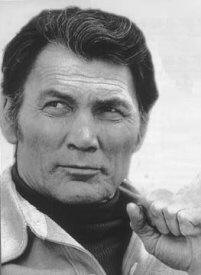|
In Remembrance: Jack Palance
Born Vladimir Palaniuk on February 18, 1919 in Lattimer Mines, PA, Palance joined his father in the area’s anthracite coal mines while still a boy. Although he won a football scholarship to University of North Carolina, he dropped out after two years. In the late `30s he began to box professionally under the name Jack Brazzo, accumulating a reported 15 consecutive victories, 12 of them by knockout, before losing in a decision to future heavyweight contender Joe Baksi. Palance put his boxing career on hold in 1942, enlisting in the Army Air Corps. While on a training flight over southern Arizona, his B-24 Liberator caught fire, forcing him to parachute to safety. The accident damaged his face, but Army doctors were able to perform plastic surgery, leaving Palance with his distinctive rugged, gaunt look. Following his discharge in 1944, Palance used the GI Bill to attend Stanford University, graduating in 1947 with a degree in drama.
Palance’s major acting break came when he understudied Marlon Brando in the Broadway production of A Streetcar Named Desire. Brando had set up a punching bag in the theater’s boiler room and invited Palance to join him in workouts. One evening, Palance threw a hard punch that missed the bag and landed on Brando’s nose, sending him to the hospital and Palance on to the stage that evening. The play’s director, Elia Kazan, was so impressed with Palance’s work, that he persuaded 20th Century Fox Studios to give Palance a contract. Kazan then cast Palance as a killer infected with the bubonic plague being tracked by the FBI in the noir thriller Panic In The Streets (1950).
Palance quickly became associated with villainous roles. He received a Best Supporting Actor Academy Award nomination for his third film Sudden Fear (1952) in which he played an actor stalking Joan Crawford on a train. He followed that up with the role of the tight-lipped gunfighter hired to gun down Alan Ladd in Shane (1953), for which he received a second Oscar nomination. Other notable films in which Palance played the heavy include Arrowhead (1953), Man In The Attic (1953) in which he played Jack The Ripper and Sign Of The Pagan (1954) where he played Attila the Hun. For 1955’s I Died A Thousand Times, a remake of the Humphrey Bogart classic High Sierra, Palance took over Bogart’s classic role of a murderer on the run from the law.
Palance also essayed more straightforward dramatic roles in such films as Flight To Tangiers (1953), The Big Knife (1955) and The Man Inside (1958). He also appeared in such westerns as The Lonely Man (1957) and The Desperadoes (1969).
In the early 1960s Palance began to worry about typecasting, so he
relocated his family to Lausanne,
Switzerland. Unfortunately, with few exceptions, the roles he was
offered were little better than the work he was getting from
Hollywood. One of those exceptions was the 1963 drama
Contempt (ala Le Mepris), directed by Jean-Luc Godard, in
which Palance played a stern Hollywood mogul. Although the rest of
the cast spoke in French, Palance’s dialogue was in English. By the
late 70s and early 80s, Palance’s fortunes had slid somewhat and he
found himself starring in several low-budget features including
Hawk The Slayer (1980) and Gor (1988). He would be openly
dismissive of these films in later interviews.
Palance’s career took an upswing when he made appearances in the western Young Guns (1988) and director Tim Burton’s comic book adaptation Batman (1989). For the 1991 comedy City Slickers, Palance spoofed his own tough guy image and earned an Academy Award for Best Supporting Actor. While receiving his award, Palance dropped to the stage and did several one-armed pushups. The ceremony’s host Billy Crystal, who has co-starred with Palance in City Slickers, turned the incident into a running gag for the rest of the evening.
In addition to his film work, Palance made many television series appearances, mostly on the anthology drama shows of the 1950s and early 60s. He won an Emmy Award for his portrayal of boxer Mountain McClintock on Playhouse 90’s adaptation of Rod Serling’s Requiem For A Heavyweight. He also starred in the short lived series The Greatest Show On Earth and Bronk in the 1960s. He had more success in 1980s co-hosting Ripley’s Believe It Or Not with his daughter Holly.
Palance was always fiercely proud of his small town Pennsylvania home as were its residents of him. There is a story, perhaps apocryphal, that tells of a theater owner in nearby Hazleton who advertised a run of a Palance movie with “Starring Hazleton’s own, Jack Palance” on the marquee. Angry Lattimer Mines residents reportedly visited the theater undercover of darkness and graffitied the posters on the front of the theater to correct the manager’s mistake.
Palance’s final big screen appearance was as the menacing pirate Long John Silver in the 1999 adaptation of Robert Louis Stevenson’s Treasure Island. |
 Jack Palance, the character actor best remembered for his many
villainous roles but who earned an Academy Award for playing against
that stereotype in City Slickers (1991), has passed away on
November 10, 2006 in Montecito, CA. He was 87.
Jack Palance, the character actor best remembered for his many
villainous roles but who earned an Academy Award for playing against
that stereotype in City Slickers (1991), has passed away on
November 10, 2006 in Montecito, CA. He was 87.